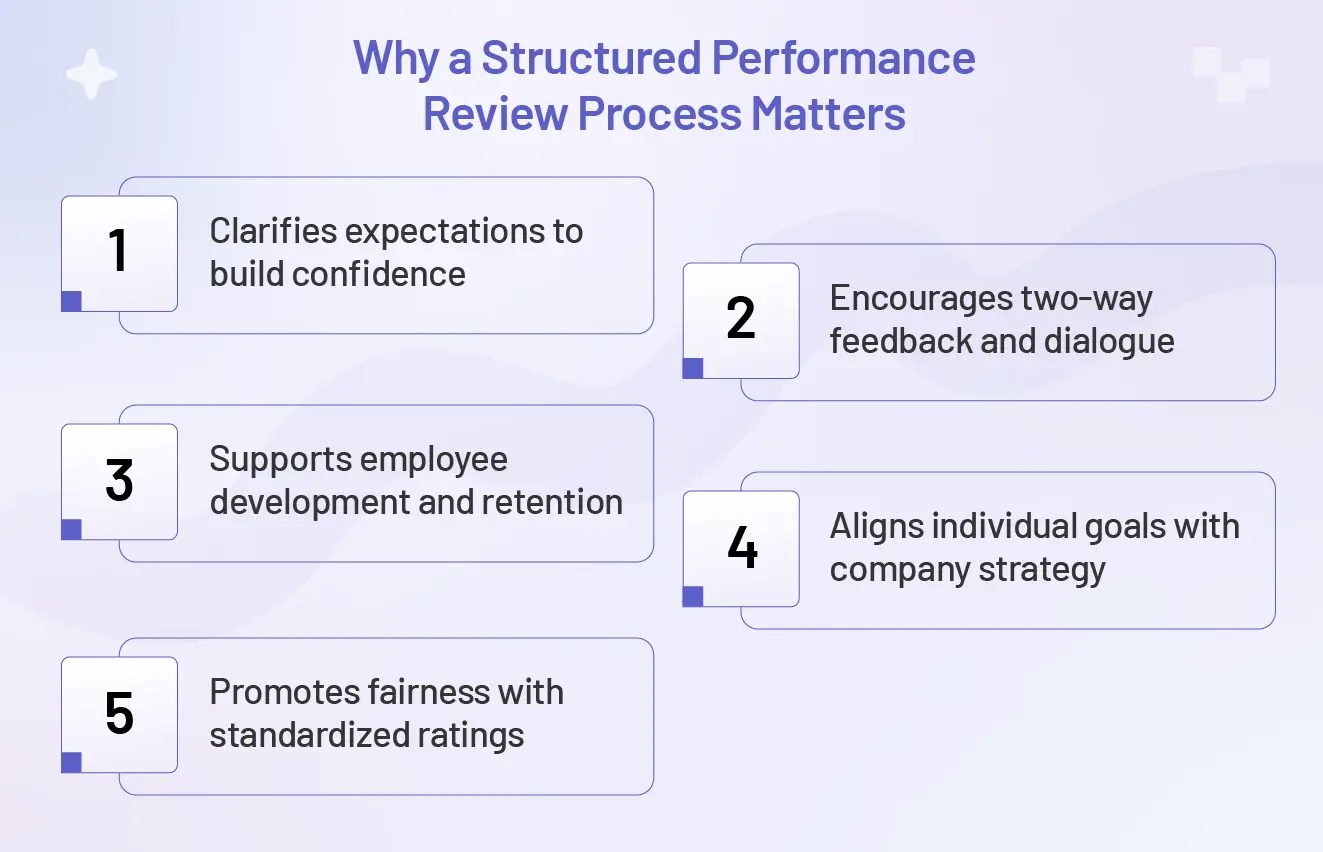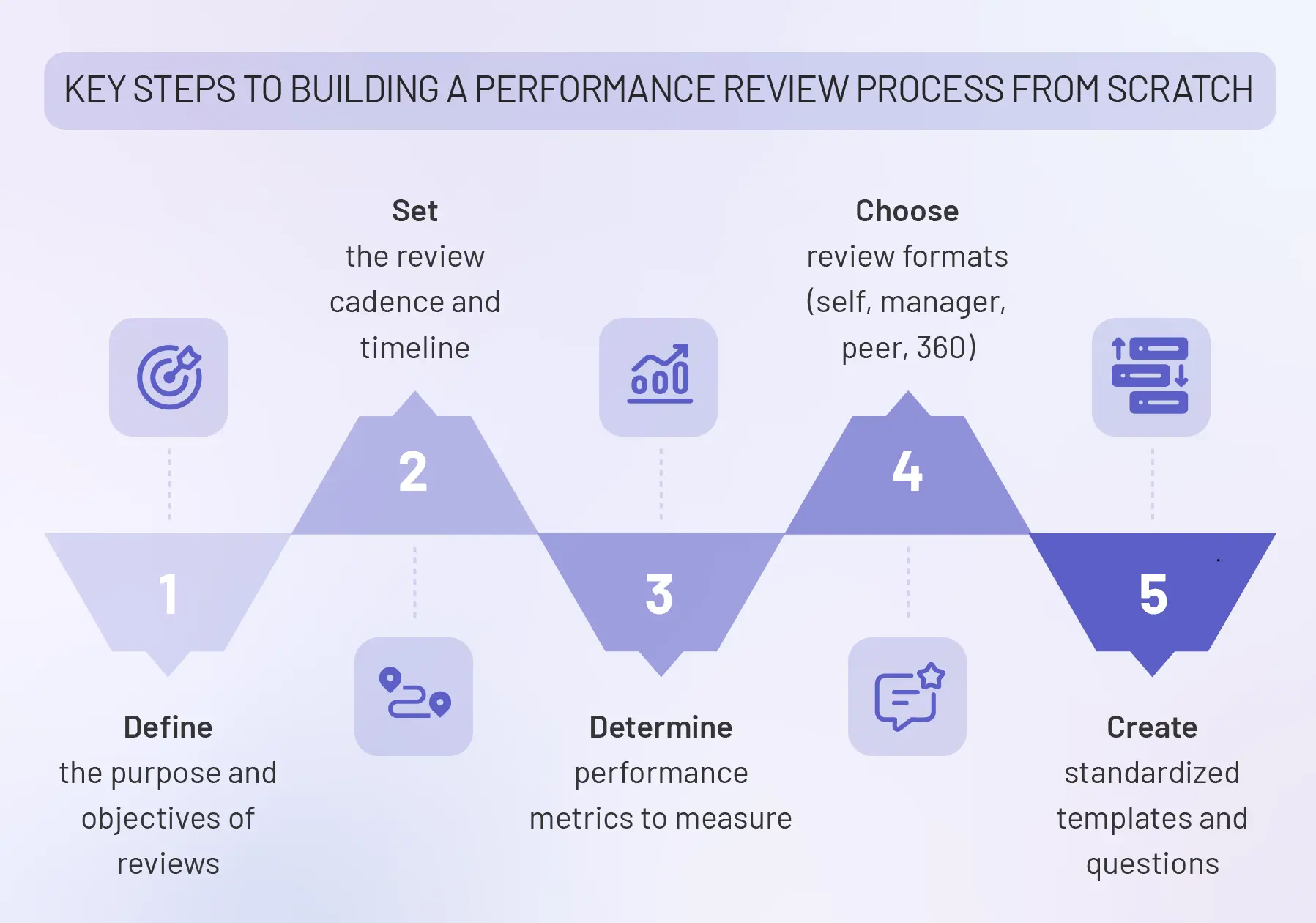Get the Ebook
.svg)
Building a performance review process from scratch might feel overwhelming, but it doesn't have to be.
Whether you're a growing startup that's outgrown informal check-ins or an established company looking to revamp outdated practices, this guide will walk you through creating a system that actually works.
We'll cover the essential steps to build a performance review process that drives real results from defining your goals to implementing feedback loops that stick. By the end, you'll have a clear roadmap for creating reviews that employees actually value and managers can confidently deliver.
Let's start with why getting this right matters so much for your organization.

When reviews happen sporadically or depend entirely on a manager's personal style, problems multiply fast. Some employees get detailed feedback while others hear nothing for months. Pay decisions feel arbitrary. High performers leave because they don't see a future, while underperformers coast because no one addresses the issues.
The research backs this up:
A well-designed review process changes the game entirely. When employees know exactly when reviews happen, what they'll cover, and how they tie to career growth, something shifts. Conversations become less about judgment and more about development.
Consider what happens when you implement regular, structured reviews:
According to the very same research we referred to above, companies with effective performance management systems see 14.9% lower turnover rates. So we can see that building a strong performance review process from the ground up goes beyond just helping retain employees, but building institutional knowledge and maintaining momentum.
Maybe you're thinking, "We handle reviews fine without a formal process." But informal approaches often hide serious issues:
Building a high-impact performance review process requires a strategic approach rooted in preparation, clarity, and dialogue.
Here's a table that summarizes the best practices when building a performance review process:

Ready to build your performance review process? Let's break it down into manageable steps you can actually implement.
What's essential here is that you see this as a blueprint. You don't need to tackle everything at once. Start with the foundations, test what works for your team, and refine as you go. Most companies find they can roll out a basic framework in 6-8 weeks, then improve it over time based on feedback.
Here's where to begin:
Before you write a single review question or schedule any meetings, answer this critical question: What do you actually want reviews to accomplish?
While this may sound obvious, many companies often skip this step. While your reviews can include multiple different sections, that address different review purposes, having a clear line of sight into the core benefits you wish to gain from your review process is a must.
Your reviews can't effectively handle promotions, development planning, compensation decisions, goal-setting, and performance documentation all at once. Something has to be the priority.
Pick your primary focus (choose 1-2 maximum):
Quick gut check: If you could only accomplish one thing with your reviews, what would have the biggest impact on your business right now? Start there. You can always expand the scope and create multiple cycles once the foundation is solid.
If you choose goal alignment, you'll spend more time connecting individual work to team and company objectives. Using an OKR tool becomes invaluable. it keeps goals visible and measurable throughout the review cycles.
How often should you run performance reviews? There's no universal answer, but there's definitely a wrong choice: picking a schedule that doesn't match your company's reality.
The fastest way to kill a review process is to commit to quarterly reviews when you barely have bandwidth for annual ones. Start with what's sustainable, then increase frequency once the process runs smoothly.
Think about your company's rhythm. Answer questions such as these:
Your review cycle should complement your company's natural cadence not compete with.
Fast-moving startups often thrive with quarterly reviews because priorities shift quickly and frequent feedback keeps everyone aligned. But this only works if reviews are lightweight. Along the lines of 30-minute check-ins, not multi-hour evaluations.
Growing companies (50-200 employees) typically find their sweet spot with biannual reviews plus monthly one-on-ones. This balances thoroughness with practicality as you scale.
Established organizations might stick with annual comprehensive reviews supplemented by quarterly goal check-ins. The key is ensuring feedback doesn't disappear between formal reviews.
Define performance metrics that reflect your company’s values and job expectations. Focus on 3-5 key areas that truly indicate success in each role. Your measurement criteria should answer one simple question: "How do we know if someone is doing a great job?"
Three universally applicable metrics you can measure in your performance appraisals include the following:
The clarity test: Can a new employee read your measurement criteria and understand exactly what success looks like? If not, keep refining.
For help creating consistent measurements across teams, explore different performance rating scales that work for your organization.
Who should weigh in on performance? Just the manager? The employee themselves? Everyone they work with?
The answer depends on what you're trying to learn. Different perspectives reveal different truths about performance, and the format you choose sends a strong signal about your company culture.
Manager-Only Reviews: The traditional approach: Your boss evaluates you, period.
When it works: Small teams, clear hierarchies, or when you're just starting out. It's simple, fast, and requires minimal coordination.
Self-Assessments: Employees evaluate their own performance first.
When it works: Always include this, even if just as a conversation starter. People often judge themselves more harshly than their managers do, and comparing perspectives reveals valuable insights.
Peer Feedback: Colleagues at the same level provide input.
When it works: Collaborative environments where teamwork drives results. Engineers reviewing code together, marketers on shared campaigns, sales teams working accounts jointly.
360-Degree Feedback: Multiple different parties including manager, peers, direct reports, even clients sometimes, weigh in on the review.
When it works: Leadership development and senior roles where influence spans multiple directions. If someone manages people AND projects AND stakeholder relationships, you need the full picture.
Making the strategic choice:
Instead of defaulting to one format company-wide, match the format to the role:
The hybrid approach that actually works:
Most successful companies use a combination. Here's a practical framework:
Modern performance management software makes this much easier by automating feedback collection and organizing multiple perspectives into coherent insights. Tools like Teamflect can handle all the performance review formats we have listed above, and do it all right inside Microsoft Teams.
Consistency is crucial for fair performance evaluations. Building performance review templates makes sure your performance review process is standardized across the organization. While each department will have differing questions and metrics, all reviews need to meet certain standards and include certain sections to ensure fair assessment.
These sections include:
Grab our free templates to get started:
You don't need to start from scratch. We have plenty of tried and tested performance review templates you can download and start using right away:
While these templates are great, using manual performance review templates, especially as numbers grow, can become cumbersome.
Here is an entire library of customizable performance review templates built right into Microsoft Teams & Outlook:
Your review process is only as good as the managers running it. Train reviewers and reviewee's alike in how the new performance review program you are implementing will function. Some training areas include:
Communicating to the full team:
Don't just train managers. Prep everyone. Send a simple one-pager covering:
For performance appraisals to have any impact whatsoever, there has to be some follow through.
Lock in next steps immediately
Before anyone leaves the review meeting:
Make progress visible
Track commitments where everyone can see them. Whether that's in your project management tool, performance review software, or a simple shared document. Keeping employee progress visible and encouraging accountability drives performance.
Build in checkpoints
This rhythm maintains momentum between annual reviews. Our mid-year review guide shows how to run these without creating review fatigue.

There is only so much you can do with manual performance review templates. To run an effective performance review process across your organization requires a software solution that will integrate every facet of employee performance into your review process. If your organization is in the Microsoft ecosystem, Teamflect is exactly what you need:
Whether you're implementing your first structured process or upgrading from spreadsheets, having the right platform ensures consistency and actually drives the outcomes you planned for.
Ready to learn more? You can schedule a quick call with an expert to analyze your performance review needs:
Shifting from static performance review cycles to a culture of ongoing feedback. Transitioning away from rigid, calendar‑driven appraisals toward continuous feedback matters. It represents a critical advancement in employee engagement.
Short, frequent check‑ins combined with candid, ongoing development conversations convert the traditional performance review from a compliance exercise into a practical mechanism for growth.
An all-in-one performance management tool for Microsoft Teams
